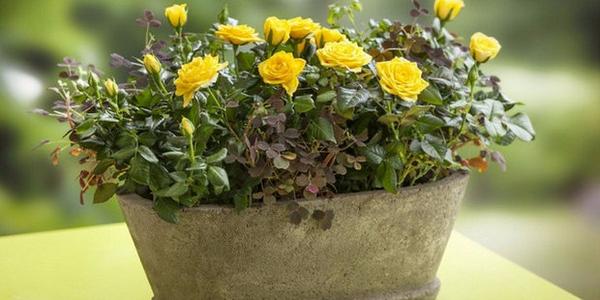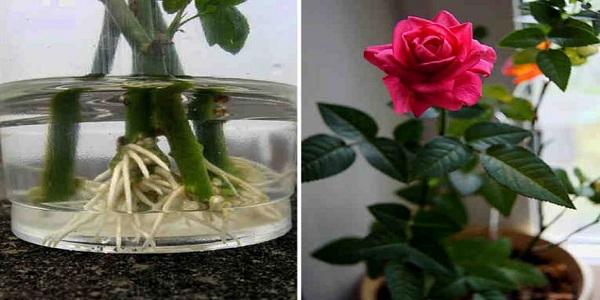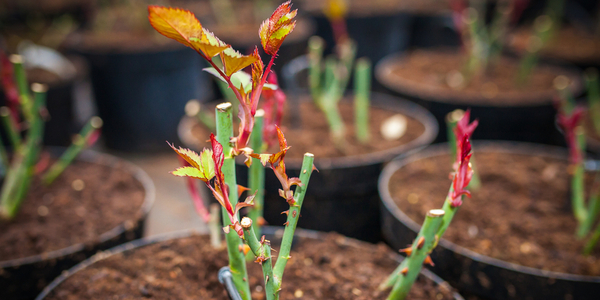Content:
Many housewives prefer indoor roses to other plants. Enthusiastic growers all the more cannot resist this beautiful flower. A pot rose must necessarily be in every home, if only because it blooms beautifully almost all year round, and when you get tired of it, you can plant it in open ground. But not many people know how to take care of her at home.
What a beginner needs to know before buying a potted rose
The quality of flowering does not depend on the number of plant inflorescences. It is very important that the flower has many young shoots. Their number and healthy appearance indicate that the rose feels great in the proposed conditions. In addition, such a plant takes root more easily during transplantation. But this procedure does not end with caring for a home rose.
Before starting to grow a rose in a pot at home, a beginner should know:
- how to adapt the plant to room temperature;
- how to carry out a contrast shower;
- what pests and diseases can affect the plant.
A rose like a flower in a pot is very moody and requires close attention. A novice florist may face difficulties immediately after buying a plant, bringing it home. Lush flowers that delight the eye on store shelves owe to special stimulants, the action of which is short-lived. Even the packaging of these flowers contains moisture stabilizers. Without these funds, the plant can dry out quickly. To prevent this from happening, you need to take some precautions:
- as soon as the rose in the pot has got home, it must be removed from the packaging, which helps to retain moisture, provoking the development of fungal diseases;
- you need to immediately cut off the spoiled leaves;
- the bearing stem and buds are recommended to be removed, in the same way as for a spray rose after purchase;
- if there are several plants in one pot, then they need to be planted;
- the rose should be treated with antifungal agents such as fitoverm or phytosporin. Also, these preparations are sprayed on the plant to get rid of pests.
The correct cultivation of a rose in a pot is not limited to the above activities.
Transplanting a rose into a pot after purchase
On the shelves in stores, the plant is sold in a pot of peat. At home, when transplanting into another container, the root system of the rose must be cleaned of it. This will further simplify the task of caring for the flower.
The grower may have problems of the following types:
- a sufficient amount of water will not flow to the root system in peat, even if the top layer of the earth is saturated with moisture in sufficient quantity;
- there will be no way to find out if there is enough moisture for the plant, since there is no way to look into the peat layer;
- in some cases, the flower can rot if you do not adhere to the rules of agricultural technology.
Before transplanting the plant into another pot, you need to carefully examine it, remove all dried out parts, and also be sure to cut off the peduncle. If this is not done, then the plant will slow down and it may die. Therefore, it is worth giving the plant time to adapt to indoor conditions. After the root system is fully strengthened, new flowers will appear on the peduncle.
To choose the right pot, you should take into account the shade of the flower and the interior surrounding it. It is best to choose them from wood or ceramic. In rare cases, plastic pots are used, as they are less reliable. Clay ones will not work either, since the walls of the pot will absorb water, taking it away from the plant.
The substrate in the pot must be moisture and air permeable. Best of all, when the composition includes 4 parts of sod land and humus, one part of sand. The stores sell a ready-made substrate for transplanting a room rose into pots.
Also, a drainage system should be provided in the pot so that water passes through the entire substrate. The main thing is that the drainage holes do not release moisture too quickly.
How to transplant a rose stalk into a pot after purchase
Cutting is the most effective way to propagate indoor roses at home, shrub garden queen, floribunda and many other varieties of this genus. There is a legend that once a branch of a rose hip, from which modern roses originated, fell to the ground and sprouted into a beautiful flower. A plant from a cuttings will take root much faster than one that is bred by selection.
It is best to use the vegetative cuttings method. The branches that remain after pruning are used as the main material. The stem should not exceed 15 cm in length and have at least 4 buds.
When using a mixture of peat with sand, the cuttings are placed in impromptu greenhouse conditions under the bag. If new leaves appear, this means that the root system is actively developing. Gradually, the plant is adapted to indoor conditions.
Transplanting a room rose in pots is allowed in the spring or at the end of August.
How to care for a rose in a pot
Every novice florist wants to know how to care for a rose in a pot, watering rules, and about the optimal temperature regime. And caring for a potted rose is very simple and consists of the following activities:
- Correct lighting. The plant loves to bask in the sun, but it is important to remember that direct sunlight harms the plant: the buds wither and fall off, and the inflorescences quickly open up and immediately fall off. In winter, when there is not enough natural light, it is recommended to use special phytolamps. Their light range should cover the blue and red spectra.
- Air humidity should be within normal limits. The life span of a plant and the splendor of its flowering directly depend on this indicator. In summer and winter, air must circulate in the apartment near the plant. In addition, you need to spray the rose from a spray bottle several times a day. Wet expanded clay in a pallet, where a pot with a room rose is placed, will perfectly help to get out of this situation and provide constant moisture.
- Watering. In the heat, the plant should be provided with abundant watering. From September, the rose needs to be rearranged to another place for the autumn-winter period. The frequency of watering at this time is reduced, the plant is placed away from the batteries in a cool room. It is recommended to drain excess water from the pallet. The flower can rot if it is watered a lot or, conversely, start to dry due to lack of moisture. During watering, the water should be at room temperature.
- Temperature conditions. It is not recommended to overheat the indoor plant, as this will lead to the development of diseases.
- How to properly prune a rose after flowering in a pot? This is best done during the fall.The shoot is shortened to 5 buds. Thin and weak branches are also pruned.
- Peace. As soon as the last flower falls, a dormant period begins, which lasts until February.
For some, it may seem that growing a rose at home on a windowsill is unrealistic. But everything is possible if you strictly follow the rules described above. Flower care begins immediately after purchase. If you miss even the slightest detail, you can not even dream of a lush blooming rose.
















